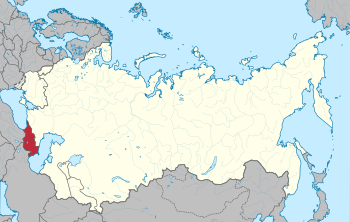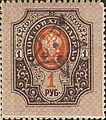Transcaucasian Socialist Federative Soviet Republic facts for kids
Quick facts for kids
Transcaucasian Socialist Federative Soviet Republic
|
|||||||||||||||||
|---|---|---|---|---|---|---|---|---|---|---|---|---|---|---|---|---|---|
| 1922–1936 | |||||||||||||||||
|
Emblem
(1930–1936) |
|||||||||||||||||

Location of the Transcaucasian SFSR (red) within the Soviet Union
|
|||||||||||||||||
| Status | Union Republic of the Soviet Union (1922–1936) |
||||||||||||||||
| Capital | Tiflis (Tbilisi) | ||||||||||||||||
| Common languages | Armenian Azerbaijani Georgian Russian |
||||||||||||||||
| Demonym(s) | Transcaucasian | ||||||||||||||||
| Government | Federal Soviet socialist republic | ||||||||||||||||
| Legislature | All-Caucasian Congress of Soviets | ||||||||||||||||
| History | |||||||||||||||||
|
• Established
|
12 March 1922 | ||||||||||||||||
|
• Disestablished
|
5 December 1936 | ||||||||||||||||
| Area | |||||||||||||||||
|
• Total
|
186,043 km2 (71,832 sq mi) | ||||||||||||||||
|
• Water
|
2,785 km2 (1,075 sq mi) | ||||||||||||||||
|
• Water (%)
|
1,49 | ||||||||||||||||
| Currency | Transcaucasian rouble, Soviet rouble | ||||||||||||||||
|
|||||||||||||||||
| Today part of | |||||||||||||||||
The Transcaucasian Socialist Federative Soviet Republic (or TSFSR) was a part of the Soviet Union. It existed from 1922 to 1936.
This republic included three areas: Armenia, Azerbaijan, and Georgia. These regions are known as the "Transcaucasian Republics." They are separated from Russia by the Caucasus Mountains.
The TSFSR was one of the four original republics that formed the Soviet Union in 1922. It was created to help the economy and strengthen the control of the Bolsheviks (a political group) in the region. In 1936, the TSFSR was dissolved. Its three parts became separate republics within the Soviet Union.
Contents
How the Transcaucasian SFSR Began
The idea for a united Transcaucasian state started after the Russian Empire ended in 1918. This happened after the October Revolution. The provinces in the Caucasus region broke away and formed their own state. It was called the Transcaucasian Democratic Federative Republic.
However, this federation only lasted two months. Different ethnic groups had their own interests. Also, there was fighting with the Ottoman Empire during World War I. Because of these problems, the federation dissolved in April 1918.
From Independent States to Soviet Republics
After the federation broke up, three new states were formed. These were the First Republic of Armenia, the Democratic Republic of Azerbaijan, and the Democratic Republic of Georgia. They existed until the end of the Russian Civil War.
During this war, the Red Army invaded these areas. They became Soviet republics. On March 12, 1922, these three Soviet Republics—Armenian SSR, Azerbaijani SSR, and Georgian SSR—joined together. They formed the Federative Union of Socialist Soviet Republics of Transcaucasia.
Forming the TSFSR
On December 13, 1922, this union changed. The First All-Caucasian Congress of Soviets turned it into a single federal state. It was renamed the Transcaucasian Socialist Federative Soviet Republic (TSFSR). Even so, the individual republics kept some of their independence.
The Congress also created a constitution and a government. Mamia Orakhelashvili, a Georgian Bolshevik leader, became the first head of the government. The capital city of the TSFSR was Tbilisi.
Joining the Soviet Union
The TSFSR became a founding member of the Soviet Union on December 30, 1922. It joined with the Russian SFSR, the Ukrainian SSR, and the Byelorussian SSR.
In December 1936, the TSFSR was dissolved. Its parts became separate Soviet Republics again. These were the Georgian, Armenian, and Azerbaijani SSRs.
Autonomous Regions within the TSFSR
Within the TSFSR, there were also smaller regions with some self-rule. These were called autonomous republics.
- Abkhazia: After the Red Army invasion of Georgia, Abkhazia was declared a Soviet Republic in March 1922. It signed an agreement with the Georgian SSR. This made it a "treaty republic." Through Georgia, Abkhazia joined the TSFSR. Later, in February 1931, Abkhazia's status changed. It became an Autonomous Soviet Socialist Republic within the Georgian SSR.
- Adjara: The Adjar ASSR was created in July 1921. It was part of the Georgian SSR. This happened because of the Treaty of Kars. This treaty divided a region between Georgia and Turkey. The northern part, with many Georgian Muslims, became part of Soviet Georgia. It was given autonomy (self-rule).
- Nakhchivan: Another autonomous republic was formed in July 1920 in Nakhchivan. This area borders Armenia, Turkey, and Iran. Both Armenians and Azerbaijanis claimed it. After the Red Army took control, the Nakhchivan Autonomous Soviet Socialist Republic was declared. It had "close ties" to the Azerbaijani SSR. Treaties later confirmed Nakhchivan as an autonomous republic under Azerbaijan's protection.
Stamps and Postal History
Before 1923, Georgia, Armenia, and Azerbaijan each had their own postage stamps. The Transcaucasian Federation started issuing its own stamps on September 15, 1923. These new stamps replaced the separate ones on October 1.
The first stamps were Russian and Armenian stamps with a star overprinted on them. This star had the letters 'ZSFSR' (the Federation's initials) inside. Because of high inflation, new stamps were soon issued. These stamps had designs showing oil fields or Soviet symbols over mountains. Their values ranged from 40,000 to 500,000 roubles.
Later, some stamps were re-issued with values in gold kopecks. Starting in 1924, the Federation began using stamps from the main Soviet Union.
Most of these stamps are not very rare today. However, stamps overprinted on Armenian stamps can be more valuable. Used stamps are less common than unused ones.
See also
 In Spanish: República Socialista Federativa Soviética de Transcaucasia para niños
In Spanish: República Socialista Federativa Soviética de Transcaucasia para niños
- Kars Republic
- Mountain Autonomous Soviet Socialist Republic
- Lithuanian–Belorussian Soviet Socialist Republic
- Far Eastern Republic
- Don Republic
- Kuban People's Republic
- Bavarian Soviet Republic
- Republics of the Soviet Union
- Komancza Republic








